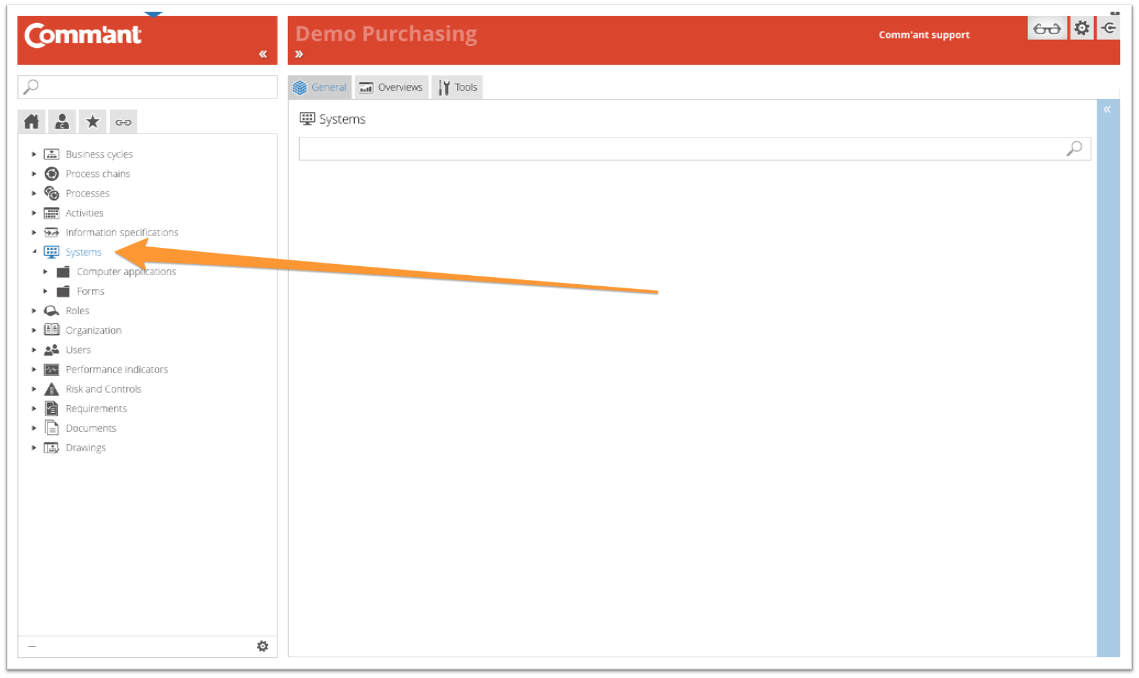Systems
A System is a tool that is used to actually register, transfer or transport data and subsequently support the retrieval or consultation of information.
For example, a System can be:
- a form
- a standard document
- a screen of an application
- a module of an application
- a specific workflow (chain of transactions)
- a computer application as a whole
- or other means of storing, transferring, retrieving, and thus communicating information

- a form/document/link to a computer application can be displayed.
- a System can have links to one or more information flows. It indicates the information flows for which this System is used to receive or provide the content.
- the roles can be specified to clarify which employee is responsible for the System. An example of a role, is the application manager.
Folder structure/groups
The folder structure under Systems reflects a choice made when designing the Comm’ant system. Often a subdivision is made according to system type (Document, application, etc.).
When you click on a folder or group, the tree structure opens and at the same time, Comm’ant shows the contents of the folder in question on the Main screen. You select the contents of the folder by either clicking on a System in the tree structure or in the Main screen. Both in the tree structure and in the Main screen you can navigate further down to the lowest level.
Selected System
After selecting, the Main screen shows more detailed information about the System.
Note: These fields are only shown when they contain information.
Remarks
If Remarks are included with the System, it will be displayed.
Comments
If a comment is included with the System, it will be displayed.
Boxes
At the bottom are the boxes that show which attributes are linked to the selected System. These boxes show the attribute title in the top bar with the specific attributes below. These blue boxes represent the attributes that are directly associated with the object.
By clicking once on the top bar, all Boxes are minimized or maximized. Clicking on the same spot again has the opposite effect.
Connections of a selected System
Just above the Navigation menu is the button ![]() that opens the Links-tab. This button shows the Links menu instead of the Navigation menu; an overview of the direct and indirect links of a selected System to other objects:
that opens the Links-tab. This button shows the Links menu instead of the Navigation menu; an overview of the direct and indirect links of a selected System to other objects:
| Links to | Links how |
| Process chains | To supra-level where Process with Information flows is located |
| Processes | To supra-level where Process with Information flows is located |
| Information flows | directly |
| Roles and positions | directly |
| Documents | directly |
Note: The Links button ![]() has two options: Linked objects and Dynamic links.
has two options: Linked objects and Dynamic links.
- With ‘Dynamic links menu’
 enabled, the links menu will alter every time a different element is displayed on the Main screen.
enabled, the links menu will alter every time a different element is displayed on the Main screen. - With ‘Linked objects menu’
 enabled, the links menu will remain the same regardless of what is displayed on the Main screen.
enabled, the links menu will remain the same regardless of what is displayed on the Main screen.
The default setting of this button is the ‘Linked objects menu’, but hovering over the button enables you to select ‘Dynamic links menu’ as well. With ‘Dynamic links menu’ enabled, the icon gets an asterisk for recognition: ![]() .
.

